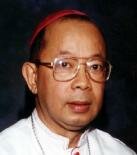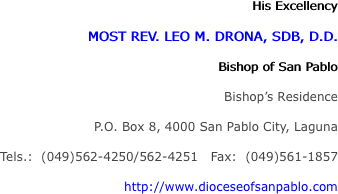The Catholic Bishops' Conference of the Philippines
The Official Website of
CBCP Online

The World Youth Day celebration held in Manila last January brought the youth of the diocese together to prepare themselves spiritually for the arrival of John Paul II. Almost 5,000 delegates undertook catechetical reorientation and went to Manila to be with the Pope personally.
An important event in the life of the diocese was the celebration of the First Diocesan Synod of the Diocese of San Pablo held from April 28 to 30 in 1994. It was held in response to the Second Plenary Council of the Philippines' call to renewal and revitalization in the faith and in the christian life. The acts and decrees that emerged from that diocesan synod have been compiled and published, and they are now in the implementation phase.
The San Pablo Diocesan Pastoral Plan which evolved from the synod focuses on a Diocesan Renewal: a renewed vision of the local church as a church of the poor; a true communion among clergy and laity; the constitution of the Christian family as a domestic church; and renewed evangelization through the unceasingly proclamation of the Good News to all.
His Holiness John Paul II has accepted the resignation of the diocese's first bishop, Most Reverend Pedro R. Bantigue, due to advanced age, and has designated Bishop Francisco San Diego, Apostolic Vicar of Palawan, to be his successor. The faithful of the Diocese of San Pablo affectionately thank Bishop Pedro Bantigue for all that he has accomplished for the diocese.
There are now 163 priests and religious serving in the 67 parishes of the Diocese of San Pablo; there are 43 Catholic institutions that include pastoral centers; and there are 39 BEC's and faith communities.
The Diocese of San Pablo was erected by the Apostolic Letter Ecclesianum Perempla on November 28, 1966, separating it from the Archdiocese of Lipa to which it had belonged since 1910. On April 18, 1967, Bishop Pedro N. Bantigue was installed as its first bishop. The diocese is a suffragan of the Archdiocese of Manila.
The diocese comprises the territories of San Pablo City and the civil province of Laguna. This province lies in southern Luzon and is one of the Tagalog-speaking provinces that lie in close proximity to the City of Manila. It hems in three sides of Laguna Lake, the largest inland lake in the country which is also called Laguna Bay as it is believed that it had once been part of Manila. Its neighbors are Rizal, Cavite, Batangas and Quezon provinces, all belonging to Region IV.
Nature has blessed Laguna with fertile soil, abundant rainfall and a mild tropical climate. It is where the University of the Philippines agricultural school is located, and where the International Rice Institute continues to experiment with different strains of rice. The province is now part of the government's industrialization program called the CALABARZON.
Historically Calamba in Laguna is known by every school child in the country as the birthplace of the Philippines' national hero, Dr. Jose Rizal – the personification of a people's struggle against exploitation.
When Bishop Pedro N. Bantigue arrived, there were only 48 diocesan priests for 34 parishes. Some of the parishes like San Pablo, Calamba and Biñan had large populations scattered over wide territories. As new priests were recruited, and eventually new priests of the diocese were ordained, new parishes were finally created. In the last twenty-eight years, the number of parishes has doubled. At present there are 67 parishes in the entire province.
Part of the solution to the lack of priests was the opening of a high school seminary in San Pablo City in 1968. This minor seminary stayed open for about thirteen years until 1981 when St. Peter's Seminary, a college seminary, was established. In March 1985, the seminary produced its first thirteen graduates, and in 1989, eleven of those first graduates were ordained to the priesthood. Since then these ordinations have continued, and this has contributed immensely to a revitalization of the religious life of the community.
At present the religious outlook of the Catholic faithful in the diocese is at a high peak. A large number of lay people participate in the religious activities of the parishes. Churches are packed full on Sundays. But more work remains to be done to reach out to the far-flung areas and to impart religious instruction to a still growing population now in the vicinity of 1,6000,000, of whom 85 per cent are Catholics.
|
Diocesan Curia |
|
Clergy |
|
Parishes |
|
Educational Center |
|
Institutions |
|
Statistics |

Diocese of San Pablo

